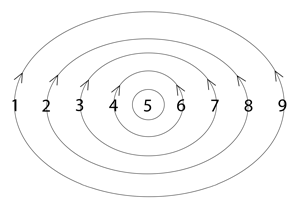inner
5-1-6
Conventional Understanding
We typically define “inner” as belonging to or located inside something, creating an artificial boundary between supposed interior and exterior realms. Spiritual traditions emphasize “going inner” to find truth, positioning an “inner world” as separate from and often superior to external experience. This perspective imposes a directional, spatial framework on what Russell reveals as simultaneous unfolding-refolding. By fragmenting experience into “inner” and “outer” territories, this understanding creates the very separation it claims to overcome, teaching us to seek through sequential “inner journey” what already exists as simultaneous process.
Resonant Understanding
Word Cosmology reveals “inner” carrying a 5-1-6 resonance pattern, the same as “sequential” – exposing how this concept imposes artificial ordering on simultaneous unfolding-refolding. Russell describes how “every growing thing which unfolds from the invisible pattern of its seed into visible form simultaneously refolds within its seed as an invisible record.” There is no “inner” journey – only simultaneous unfolding-refolding. The concept of “inner” corresponds with imposing sequential ordering on what naturally functions as simultaneous process, creating an illusory spatial direction that disrupts the integration it claims to seek.
Expressions Spectrum Analysis
In balanced expression, this resonance pattern appears as “visible,” “I see clearly,” and “peaceful.” “Self” appears across all modulation states, with its balanced expression manifesting as “individuated being” and “being the information” – the direct experience of being both distinct and connected without artificial boundaries. “Sovereignty” and “idea governance” show how self naturally organizes without rigid control, while “I am attention reflecting” shows direct participation without withdrawal.
When over-modulated, “self” appears as “constant movement” and “elitism” – rigid patterns that create artificial separation. “Achievement oriented” and “conquering” show how attention becomes directed toward fixed outcomes rather than responsive engagement.
Under-modulated expressions show “self” as “questioning” and “confused desire” – disconnection from direct experience. “Out of the loop” and “closed system” reveal what happens when self becomes isolated from responsive engagement through concepts like “inner.”
The appearance of “self” across all states doesn’t indicate persistent “self-recognition” but reveals that self as an energetic pattern of being information cannot be escaped or transcended – only expressed in balanced or distorted ways.
Russell’s Cosmogony Connection
Russell’s understanding directly challenges the concept of “inner” by revealing the simultaneous nature of process: “Every growing thing which unfolds from the invisible pattern of its seed into visible form simultaneously refolds within its seed as an invisible record of the pattern of the unfolding form.”
There is no “inner” separate from “outer” – only simultaneous unfolding-refolding. When spiritual practices direct attention “inner,” they inadvertently disrupt this simultaneity by imposing sequential ordering on process. The resonance between “inner” and “sequential” (both 5-1-6) reveals how this concept fragments what Russell describes as simultaneous unfolding-refolding.
Practical Implications
This understanding transforms how we approach practices like meditation, martial arts, or spiritual development. Many practitioners of disciplines like Shaolin achieve remarkable focused attention while labeling it “inner mastery.” The skills themselves – perceptual clarity, disciplined attention, bodily control – represent genuine accomplishments. The limitation comes from positioning these as mastery of an “inner” realm which can feel separate from “outer” experience.
This conceptual framework often creates isolation that practitioners believe is necessary for their development. They may form identities around separation (“I’m doing the hard inner work others avoid”) and fear that connection would diminish their practice.
Balanced expressions like “individuated being,” “sovereignty,” and “I share my desires” suggest that focused attention can develop without isolation. Practitioners might recognize that their distinct energetic pattern can emerge through disciplined attention without artificial separation into “inner” and “outer” domains.
By recognizing “inner” as conceptual misunderstanding rather than actual territory, we can maintain the value of these disciplines while releasing the framework that creates unnecessary isolation.
Walter Russell’s quotes are from his book, “A New Concept of the Universe”
Related Words:
No results found.


